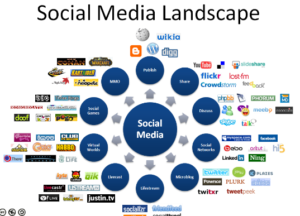Are you looking for the best small business social media tactics to guide your online marketing? If so, you have come to the right place.

Check out our thoughts on creative marketing.
You may have heard this statement before: the networked consumers know more than most companies about their products and services. Whether the facts are good or bad, they tell everybody about what they know.
Every bold new business idea starts with a success story. Either it is a single organization or an aggregate sample that implemented a particular strategy and achieved outstanding results. That solid track record helps to convince others to adopt it, yet somehow the new management fad fails to deliver as promised.
Have you had this experience with networked consumers? Certainly, it motivates you to know about small business social media tactics and marketing doesn’t it?
What is social media?
“Social media” is a way for people to communicate and interact online. While it has been around since the dawn of the World Wide Web, in the last ten years or so we’ve seen a surge in both the number and popularity of social media sites. It’s called social media because users engage with (and around) it in a social context, which can include conversations, commentary, and other user-generated annotations and engagement interactions.
Publishing content has become exponentially simpler over the last several years, which has helped skyrocket the use of social media. Non-technical web users are now able to easily create content on a rapidly growing number of platforms, including those that are owned (hosted communities, blogs, etc.), rented (social networks or third-party communities), and occupied (commenting, contributing, etc.).
For businesses, the shift in web consumerism and the accompanying rise in social media brings excellent opportunity. The real magic lies in the ability to grow lasting and scalable relationships with your organization’s customer base through social media.
Whether your business is listening and engaging or not, customers are having conversations relevant to your operations. It’s better to be part of the conversation, right?
Marketers get four main benefits from social media:
LISTENING
Every company needs to listen and to hear what customers are talking about
REACH
The number of customers you can communicate with
NURTURING
Build trust with customers and have the opportunity to educate them
RELATIONSHIP BUILDING
Increase the strength/quality of your relationships
One of the most frequent requests we get from small business owners who are either new to a social media marketing or struggling with it is to provide them with a simple system they can implement and manage to achieve success. Unfortunately, the truth is that there is no such system.
Every situation is unique and social media is as much an art as it is a science. However, having said that, there are some general social media rules that provide a framework of wisdom–wisdom that you can apply in almost every unique situation to capitalize on social media opportunities and maximize your potential for success.
While there is a virtual cornucopia of valid rules out there, the following list represents 14 core social media rules to get you started and (hopefully) headed in the right direction–towards success in your small business social media marketing!
It’s the value add
Social media is like a bank account. You simply cannot withdraw more value than you deposit into your account! Too many people wrongly view social media as an auto-pilot cash cow, money tree, or limitless personal ATM.
I assure you… it is not. It requires effort and careful planning, and you will only get out of it what you are willing to put into it.
A quick splash of value-free content will only produce quick and limited results at best. Just as Chinese food always leaves you hungry an hour later, quick social media splashes always leave you dying of thirst in a social media desert sooner rather than later.
More details: Successful Social Media Marketing Tactics You Should Employ

Social media is always on
Social media is a 24/7 business—not once a week occasion! You need to monitor and interact with others constantly. You can’t pencil in “social media time” on your Google calendar once a week and hope to be successful.
Blog content drives conversions
Don’t make the fatal mistake of using more ads to compensate for bad content. Rather, create quality content to convert to your ads. If folks don’t like your content, they are not going to stick around long enough to be converted (i.e., perform an action such as clicking or subscribing).
Likewise, more social media postings and links won’t compensate for bad content and poor headings either! It all starts with content, and everything else depends upon it for results.
Keep refreshing your pages
Keep your social media pages and profiles up-to-date and synchronized across platforms. You wouldn’t hand out old business cards with the wrong information… so don’t do it with your social media.
Focus on emotion
Social media, like most marketing, is emotion-driven. People’s behavior (e.g., sharing your content or buying your product) is based on emotional responses. Your social media content should appeal to their hearts–not their heads. (You can—and should—appeal to their heads through quality content on your website or blog)
Best social media … more channels is not a strategy
Don’t go to social media platforms because of their image… go to where your target audience is. For example, Facebook–despite its well-documented and highly touted popularity–is the last place some small businesses should go.
Don’t chase after the “best” or “most popular” networks—chase your audience! Find out where they are and live there.
Chase customers, not competitors
Just because something is working for your competitor is no guarantee that it will work for you. Chaos theory teaches that every situation is unique and requires a different model. Thus, understanding your customers is far more important than understanding your competitors.
Besides, let’s be honest, when it comes to social media, they are more than likely just blindly following somebody else! Stop being one of the three blind mice and be an entrepreneurial leader.

Measurements and more measurements
Just because you can measure something doesn’t mean you should. Not all metrics are created equal—or even worthwhile. Carefully select those metrics that provide feedback related to your social media plan and strategies.
Einstein reportedly once had a sign hanging in his office that read, “Not everything that can be counted counts, and not everything that counts can be counted.” Every social media manager should have that sign hanging in their office!
There are no magic formulas
When people try to give you a formula for how to be successful with social media–no matter how well-intentioned they may be… ignore them!
There is no formula for success–not in traditional marketing and certainly not for social media marketing. While there are some general rules (more like guidelines), such as the ones offered in this article, there are no consistently repeatedly formulas to achieve success.
Every situation is unique. Understand your situation and design a social media plan that uniquely works for you.
A schedule is needed, but it is not a strategy
While schedules are good (they are a tool for increased efficiency and productivity), they are not a social media strategy. A strategy provides both a direction and reason. Scheduling when and where you will post content provides neither. You may send a lot of lead downrange but it in no way ensures you will hit your target!
Networks channels are different
To be successful in social media requires understanding and mastering the inherent differences between social media networks. For example, Facebook embodies the spirit of pure social interaction, while Twitter is all about communicating news and information. Understand the difference and act accordingly!
Make stories a centerpiece
Marketing always has been and always will be about telling stories… stories that influence behavior and convince people to act. Make sure your social media content tells a story and that your story is compelling and relevant–especially your headlines.
Social is different from traditional marketing
The nuances of social media marketing are entirely distinct from that of classical marketing. Just as it is important to understand the differences between networks, it is equally important to understand how and why social media marketing is different from traditional marketing. (And make sure your boss or clients understand as well!)
If you are not sure about the differences, click here for a great infographic that spells out some of them. [Note: The site is not in English; however, the infographic thankfully is]
Experience is king
I’m not talking about your experience… I mean your customers’ experience! Strive to keep their experience consistent, enjoyable, and simple. For example, don’t ask them to do X, Y, and Z, or jump through 3 hoops simultaneously.
Rather, stick to just X or one hoop. Folks don’t like to make decisions, so keep the decision as simple as possible for them!
The bottom line
The purpose for you to become more actively involved with social media is to find additional opportunities to connect with customers and share information with them that they enjoy receiving.
This is the core to building customer relationships and trust. They are fundamental to winning and keeping customers,
